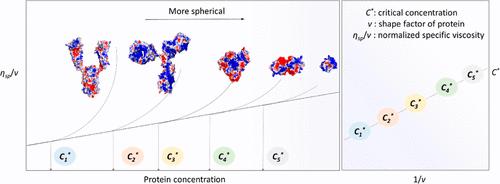当前位置:
X-MOL 学术
›
Mol. Pharmaceutics
›
论文详情
Our official English website, www.x-mol.net, welcomes your feedback! (Note: you will need to create a separate account there.)
Quantifying Protein Shape to Elucidate Its Influence on Solution Viscosity in High-Concentration Electrolyte Solutions
Molecular Pharmaceutics ( IF 4.9 ) Pub Date : 2024-02-27 , DOI: 10.1021/acs.molpharmaceut.3c01075 Zhou Tian 1 , Xuling Jiang 1 , Zhidong Chen 1 , Chengnan Huang 1 , Feng Qian 1
Molecular Pharmaceutics ( IF 4.9 ) Pub Date : 2024-02-27 , DOI: 10.1021/acs.molpharmaceut.3c01075 Zhou Tian 1 , Xuling Jiang 1 , Zhidong Chen 1 , Chengnan Huang 1 , Feng Qian 1
Affiliation

|
Therapeutic proteins with a high concentration and low viscosity are highly desirable for subcutaneous and certain local injections. The shape of a protein is known to influence solution viscosity; however, the precise quantification of protein shape and its relative impact compared to other factors like charge–charge interactions remains unclear. In this study, we utilized seven model proteins of varying shapes and experimentally determined their shape factors (v) based on Einstein’s viscosity theory, which correlate strongly with the ratios of the proteins’ surface area to the 2/3 power of their respective volumes, based on protein crystal structures resolved experimentally or predicted by AlphaFold. This finding confirms the feasibility of computationally estimating protein shape factors from amino acid sequences alone. Furthermore, our results demonstrated that, in high-concentration electrolyte solutions, a more spherical protein shape increases the protein’s critical concentration (C*), the transition concentration beyond which protein viscosity increases exponentially relative to concentration increases. In summary, our work elucidates protein shape as a key determinant of solution viscosity through quantitative analysis and comparison with other contributing factors. This provides insights into molecular engineering strategies to optimize the molecular design of therapeutic proteins, thus optimizing their viscosity.
中文翻译:

定量蛋白质形状以阐明其对高浓度电解质溶液中溶液粘度的影响
具有高浓度和低粘度的治疗性蛋白质非常适合皮下注射和某些局部注射。已知蛋白质的形状会影响溶液粘度;然而,蛋白质形状的精确量化及其与电荷相互作用等其他因素相比的相对影响仍不清楚。在这项研究中,我们利用了七种不同形状的模型蛋白质,并根据爱因斯坦的粘度理论通过实验确定了它们的形状因子 ( v ),该因子与蛋白质表面积与其各自体积的 2/3 次方的比率密切相关,基于实验解析或 AlphaFold 预测的蛋白质晶体结构。这一发现证实了仅从氨基酸序列计算估计蛋白质形状因素的可行性。此外,我们的结果表明,在高浓度电解质溶液中,更球形的蛋白质形状会增加蛋白质的临界浓度(C *),超过该浓度时蛋白质粘度相对于浓度增加呈指数增加。总之,我们的工作通过定量分析和与其他影响因素的比较,阐明了蛋白质形状是溶液粘度的关键决定因素。这为分子工程策略提供了见解,以优化治疗性蛋白质的分子设计,从而优化其粘度。
更新日期:2024-02-27
中文翻译:

定量蛋白质形状以阐明其对高浓度电解质溶液中溶液粘度的影响
具有高浓度和低粘度的治疗性蛋白质非常适合皮下注射和某些局部注射。已知蛋白质的形状会影响溶液粘度;然而,蛋白质形状的精确量化及其与电荷相互作用等其他因素相比的相对影响仍不清楚。在这项研究中,我们利用了七种不同形状的模型蛋白质,并根据爱因斯坦的粘度理论通过实验确定了它们的形状因子 ( v ),该因子与蛋白质表面积与其各自体积的 2/3 次方的比率密切相关,基于实验解析或 AlphaFold 预测的蛋白质晶体结构。这一发现证实了仅从氨基酸序列计算估计蛋白质形状因素的可行性。此外,我们的结果表明,在高浓度电解质溶液中,更球形的蛋白质形状会增加蛋白质的临界浓度(C *),超过该浓度时蛋白质粘度相对于浓度增加呈指数增加。总之,我们的工作通过定量分析和与其他影响因素的比较,阐明了蛋白质形状是溶液粘度的关键决定因素。这为分子工程策略提供了见解,以优化治疗性蛋白质的分子设计,从而优化其粘度。



























 京公网安备 11010802027423号
京公网安备 11010802027423号